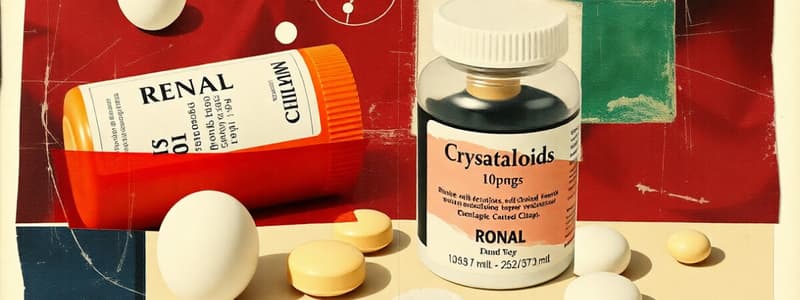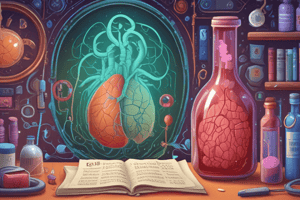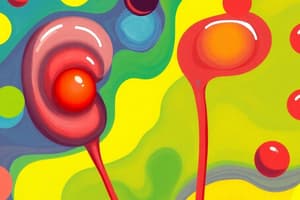Podcast
Questions and Answers
Which of the following medications can cause reflex tachycardia as a common effect?
Which of the following medications can cause reflex tachycardia as a common effect?
- Aliskiren
- Methyldopa
- Hydralazine (correct)
- Clonidine
What is the primary action of alpha-2 agonists in the central nervous system?
What is the primary action of alpha-2 agonists in the central nervous system?
- Decrease sympathetic outflow (correct)
- Stimulate sympathetic outflow
- Block renin activity
- Increase heart rate and cardiac output
Which medication is known for inducing hypertrichosis as a side effect?
Which medication is known for inducing hypertrichosis as a side effect?
- Minoxidil (correct)
- Hydralazine
- Doxazosin
- Clonidine
What common effect is associated with the abrupt discontinuation of alpha-2 agonists?
What common effect is associated with the abrupt discontinuation of alpha-2 agonists?
Which of the following statements about renin inhibitors is true?
Which of the following statements about renin inhibitors is true?
What is a key difference between ARBs and ACE inhibitors?
What is a key difference between ARBs and ACE inhibitors?
Which of the following is a common effect of Calcium Channel Blockers?
Which of the following is a common effect of Calcium Channel Blockers?
Which type of Calcium Channel Blockers primarily act on the heart and blood vessels?
Which type of Calcium Channel Blockers primarily act on the heart and blood vessels?
What is the mechanism of action of beta blockers?
What is the mechanism of action of beta blockers?
Which of the following is a common effect of non-selective beta blockers?
Which of the following is a common effect of non-selective beta blockers?
What action do alpha-1 adrenergic blockers perform?
What action do alpha-1 adrenergic blockers perform?
Which of the following examples represents a dihydropyridine Calcium Channel Blocker?
Which of the following examples represents a dihydropyridine Calcium Channel Blocker?
Which effect is least common with ARBs compared to ACE inhibitors?
Which effect is least common with ARBs compared to ACE inhibitors?
What is the site of action for potassium-sparing diuretics?
What is the site of action for potassium-sparing diuretics?
Which of the following is a mechanism of action of aldosterone antagonists?
Which of the following is a mechanism of action of aldosterone antagonists?
What is a significant side effect of potassium-sparing diuretics?
What is a significant side effect of potassium-sparing diuretics?
Which of the following is a use for potassium-sparing diuretics?
Which of the following is a use for potassium-sparing diuretics?
Which of the following substances is increased in urinary excretion when using carbonic anhydrase inhibitors?
Which of the following substances is increased in urinary excretion when using carbonic anhydrase inhibitors?
What is the primary function of the Proximal Convoluted Tubule (PCT)?
What is the primary function of the Proximal Convoluted Tubule (PCT)?
Which segment of the nephron is impermeable to water?
Which segment of the nephron is impermeable to water?
What is the primary action of carbonic anhydrase inhibitors in the kidney?
What is the primary action of carbonic anhydrase inhibitors in the kidney?
What is the mechanism of action of thiazide diuretics?
What is the mechanism of action of thiazide diuretics?
Which condition can be treated with carbonic anhydrase inhibitors?
Which condition can be treated with carbonic anhydrase inhibitors?
For which condition are thiazide diuretics commonly used?
For which condition are thiazide diuretics commonly used?
What effect do potassium-sparing diuretics have on body sodium levels?
What effect do potassium-sparing diuretics have on body sodium levels?
What effect do loop diuretics have on calcium levels?
What effect do loop diuretics have on calcium levels?
What is the main site of action for loop diuretics?
What is the main site of action for loop diuretics?
What is a common side effect of thiazide diuretics?
What is a common side effect of thiazide diuretics?
Which condition would NOT typically be treated with loop diuretics?
Which condition would NOT typically be treated with loop diuretics?
What is the primary mechanism of action of osmotic diuretics?
What is the primary mechanism of action of osmotic diuretics?
Which condition is NOT typically treated with osmotic diuretics?
Which condition is NOT typically treated with osmotic diuretics?
How do ACE inhibitors lower blood pressure?
How do ACE inhibitors lower blood pressure?
Which of the following is a common effect of taking ACE inhibitors?
Which of the following is a common effect of taking ACE inhibitors?
What is the effect of ARBs?
What is the effect of ARBs?
What is the site of action for osmotic diuretics in the nephron?
What is the site of action for osmotic diuretics in the nephron?
Which mechanism do diuretics utilize to lower blood pressure?
Which mechanism do diuretics utilize to lower blood pressure?
Which of the following drugs is NOT classified as an antihypertensive?
Which of the following drugs is NOT classified as an antihypertensive?
Which intravenous solution is considered isotonic?
Which intravenous solution is considered isotonic?
What is the main purpose of colloid solutions like albumin?
What is the main purpose of colloid solutions like albumin?
Which of the following is a mechanism for diuretic drugs?
Which of the following is a mechanism for diuretic drugs?
What is a characteristic of hypotonic solutions?
What is a characteristic of hypotonic solutions?
What electrolyte is most abundant inside cells and critical for normal body functions?
What electrolyte is most abundant inside cells and critical for normal body functions?
Which intravenous solution is categorized as hypertonic?
Which intravenous solution is categorized as hypertonic?
Which blood product is used primarily to increase oxygen carrying capacity?
Which blood product is used primarily to increase oxygen carrying capacity?
Lactated ringers is an example of which type of solution?
Lactated ringers is an example of which type of solution?
Flashcards
Alpha-2 Agonists
Alpha-2 Agonists
Medications that stimulate alpha-2 adrenergic receptors in the central nervous system (CNS), leading to a decrease in sympathetic outflow. This results in reduced norepinephrine release, vasodilation, decreased heart rate, and lower blood pressure.
Direct Vasodilators
Direct Vasodilators
Medications that directly relax the smooth muscle of blood vessels, causing vasodilation and lowering blood pressure. This reduces systemic vascular resistance (SVR).
Hydralazine
Hydralazine
A direct vasodilator that primarily affects arterial dilation, leading to lower blood pressure.
Minoxidil
Minoxidil
Signup and view all the flashcards
Renin Inhibitors
Renin Inhibitors
Signup and view all the flashcards
Isotonic Solutions
Isotonic Solutions
Signup and view all the flashcards
Hypotonic Solutions
Hypotonic Solutions
Signup and view all the flashcards
Hypertonic Solutions
Hypertonic Solutions
Signup and view all the flashcards
Crystalloids
Crystalloids
Signup and view all the flashcards
Colloids
Colloids
Signup and view all the flashcards
Potassium's Role
Potassium's Role
Signup and view all the flashcards
Diuretic Action
Diuretic Action
Signup and view all the flashcards
Packed RBC
Packed RBC
Signup and view all the flashcards
Osmotic Diuretics
Osmotic Diuretics
Signup and view all the flashcards
Examples of Osmotic Diuretics
Examples of Osmotic Diuretics
Signup and view all the flashcards
How Osmotic Diuretics Work
How Osmotic Diuretics Work
Signup and view all the flashcards
Antihypertensive Drugs
Antihypertensive Drugs
Signup and view all the flashcards
Mechanism of Action: Diuretics
Mechanism of Action: Diuretics
Signup and view all the flashcards
ACE Inhibitors
ACE Inhibitors
Signup and view all the flashcards
Effects of ACE Inhibitors
Effects of ACE Inhibitors
Signup and view all the flashcards
Angiotensin II Receptor Blockers (ARBs)
Angiotensin II Receptor Blockers (ARBs)
Signup and view all the flashcards
Potassium-Sparing Diuretics
Potassium-Sparing Diuretics
Signup and view all the flashcards
Spironolactone & Eplerenone
Spironolactone & Eplerenone
Signup and view all the flashcards
Amiloride & Triamterene
Amiloride & Triamterene
Signup and view all the flashcards
Carbonic Anhydrase Inhibitors
Carbonic Anhydrase Inhibitors
Signup and view all the flashcards
Acetazolamide & Methazolamide
Acetazolamide & Methazolamide
Signup and view all the flashcards
Effects of Potassium-Sparing Diuretics
Effects of Potassium-Sparing Diuretics
Signup and view all the flashcards
Uses of Potassium-Sparing Diuretics
Uses of Potassium-Sparing Diuretics
Signup and view all the flashcards
Effects of Carbonic Anhydrase Inhibitors
Effects of Carbonic Anhydrase Inhibitors
Signup and view all the flashcards
Proximal Convoluted Tubule (PCT)
Proximal Convoluted Tubule (PCT)
Signup and view all the flashcards
What are ARBs?
What are ARBs?
Signup and view all the flashcards
Descending Limb of Loop of Henle
Descending Limb of Loop of Henle
Signup and view all the flashcards
What is a common side effect of ARBs?
What is a common side effect of ARBs?
Signup and view all the flashcards
Ascending Limb of Loop of Henle
Ascending Limb of Loop of Henle
Signup and view all the flashcards
How do Calcium Channel Blockers work?
How do Calcium Channel Blockers work?
Signup and view all the flashcards
What are Dihydropyridines?
What are Dihydropyridines?
Signup and view all the flashcards
Distal Convoluted Tubule (DCT)
Distal Convoluted Tubule (DCT)
Signup and view all the flashcards
Collecting Duct
Collecting Duct
Signup and view all the flashcards
What are non-dihydropyridines?
What are non-dihydropyridines?
Signup and view all the flashcards
How do Beta Blockers work?
How do Beta Blockers work?
Signup and view all the flashcards
Thiazide Diuretics (e.g., Hydrochlorothiazide)
Thiazide Diuretics (e.g., Hydrochlorothiazide)
Signup and view all the flashcards
Loop Diuretics (e.g., Furosemide)
Loop Diuretics (e.g., Furosemide)
Signup and view all the flashcards
What are common side effects of Beta Blockers?
What are common side effects of Beta Blockers?
Signup and view all the flashcards
Effects of Diuretics
Effects of Diuretics
Signup and view all the flashcards
How do Alpha-1 Adrenergic Blockers work?
How do Alpha-1 Adrenergic Blockers work?
Signup and view all the flashcards
Study Notes
Renal Medications - Tonicity
- Isotonic Solutions:
- Osmotic pressure remains the same
- Examples include 0.9% NaCl (normal saline), lactated ringers (LR), and D5W (dextrose 5% in water)
- Similar solute concentration to blood plasma
- Hypotonic Solutions:
- Lower osmotic pressure than blood plasma
- Examples include 0.45% NaCl and D5W
- Cause fluid to move out of blood vessels into surrounding tissues
- Hypertonic Solutions:
- Higher osmotic pressure than blood plasma
- Examples include 3% NaCl and D10W (dextrose 10% in water), D5NS (dextrose 5% in normal saline), and D5L (dextrose 5% in lactated ringer's)
- Cause fluid to move from surrounding tissues into blood vessels
Renal Medications - Crystalloids
- Mechanism of Action:
- Contain fluids and electrolytes naturally found in the body
- Do not contain proteins, lowering risk of allergic reactions and viral transmission
- Useful for treating dehydration, replacing lost fluids, and managing fluid/electrolyte imbalances
- Promote urinary flow
Renal Medications - Types of Crystalloids
- 0.9% NS (Normal Saline)
- Lactated Ringers (LR)
- Dextrose (D5W)
- 3.3% Dextrose and 0.3% NS
- D5W and 0.225% NS (D5 1/4 NS)
- Plasma-lyte
- 0.45% NaCl
- 3% NaCl
- D5W and 0.45% NS
Renal Medications - Colloids
- Mechanism of Action:
- Contain specific albumin natural proteins
- Primarily produced in the liver
- Responsible for approximately 70% of colloid oncotic pressure (draws fluid into blood vessels)
- Sterile solutions of serum albumin prepared from pooled human blood, plasma, serum, or placenta
- Pasteurized to remove contaminants
Renal Medications - Blood Products
- Mechanism of Action:
- Only class of fluids that carries oxygen
- Increases tissue oxygenation
- Increases plasma volume
- Most expensive and least available fluid
- Increases colloid oncotic pressure and plasma volume
Renal Medications - Potassium
- Mechanism of Action:
- Most abundant positively charged electrolyte inside cells
- Makes up 95% of body's potassium
- Potassium content outside cells ranges from 3.5 to 5 mmol per liter
- Critical for normal body function (muscle contraction, nerve impulse transmission, heartbeat regulation, acid/base balance, isotonicity)
Renal Medications - Diuretic Drugs
- Mechanism of Action:
- Act on different parts of the nephron (kidney's functional unit) to interfere with sodium and water reabsorption
- Nephron Function:
- Proximal Convoluted Tubule (PCT): Primarily responsible for sodium, chloride, and water reabsorption
- Loop of Henle: Divided into descending (water permeable) and ascending (water impermeable) limbs; actively transports sodium, potassium, and chloride
- Distal Convoluted Tubule (DCT): Involved in further sodium reabsorption and regulation of potassium and calcium
- Collecting Duct: Final site of sodium and water reabsorption; influenced by aldosterone and antidiuretic hormone (ADH)
Renal Medications - Thiazide Diuretics
- Site of Action: Distal Convoluted Tubule (DCT)
- Mechanism: Inhibit sodium/chloride co-transporter, preventing sodium and chloride reabsorption
- Effects: Increased sodium, chloride, and water excretion
Renal Medications - Loop Diuretics
- Site of Action: Thick Ascending Limb of Loop of Henle
- Mechanism: Inhibit Na+/K+/2Cl− symporter, reducing sodium, potassium, and chloride reabsorption
- Effects: Profound diuresis (increased urine output); potassium, magnesium, and calcium loss; increased renal blood flow
Renal Medications - Potassium-Sparing Diuretics
- Mechanism: Block the action of aldosterone (hormone increasing sodium reabsorption) or inhibit sodium channels in the collecting duct
- Effects: Mild diuresis compared to loop/thiazide diuretics; potassium retention (hyperkalemia)
Renal Medications - Carbonic Anhydrase Inhibitors
- Mechanism: Inhibit the carbonic anhydrase enzyme in the proximal renal tubule, decreasing bicarbonate, sodium, and water reabsorption
- Effects: Increased excretion of bicarbonate, sodium, potassium, and water; metabolic acidosis
Renal Medications - Osmotic Diuretics
- Mechanism: Increase the osmolarity of the renal filtrate, preventing water reabsorption and increasing urine output
- Effects: Increased urine volume; reduced cerebral/intraocular pressure
Renal Medications - Antihypertensive Drugs
- Mechanism: Lower blood pressure by acting on various parts of the body (heart, blood vessels, kidneys, nervous system) to decrease cardiac output, reduce systemic vascular resistance, or both
- Examples: Adrenergic drugs, ACE inhibitors, Angiotensin II receptor blockers (ARBS), Calcium channel blockers, Direct renin inhibitors, Diuretics, Vasodilators
Renal Medications - Beta Blockers
- Mechanism of Action: Block beta-adrenergic receptors in heart, kidneys, and blood vessels
- Effects: Reduced heart rate, decreased myocardial contractility, lowered cardiac output, reduced renin secretion, vasodilation
Renal Medications - Alpha-1 Adrenergic Blockers
- Mechanism of Action: Block alpha-1 adrenergic receptors in blood vessels; prevents norepinephrine-stimulated vasoconstriction
- Effects: Vasodilation
Renal Medications - Alpha-2 Agonists
- Mechanism of Action: Stimulate alpha-2 adrenergic receptors in the central nervous system, decreasing sympathetic nervous system outflow; reducing norepinephrine release
- Effects: Reduced heart rate, vasodilation
Renal Medications - Direct Vasodilators
- Mechanism of Action: Relax vascular smooth muscle directly, lowering systemic vascular resistance and blood pressure
- Examples: Hydralazine, Minoxidil, Nitroprusside
Renal Medications - Renin Inhibitors
- Mechanism of Action: Block the enzyme renin, preventing the formation of angiotensin II; leading to vasodilation, decreased aldosterone secretion, and reduced blood volume
- Example: Aliskiren
Studying That Suits You
Use AI to generate personalized quizzes and flashcards to suit your learning preferences.
Related Documents
Description
This quiz explores the various types of renal medications, particularly focusing on tonicity and crystalloid solutions. It covers isotonic, hypotonic, and hypertonic solutions, along with their mechanisms of action and applications in treatment. Test your understanding of how these medications affect fluid balance in the body.



